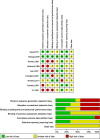Comparing external fixators and intramedullary nailing for treating open tibia fractures: a meta-analysis of randomized controlled trials
- PMID: 36604668
- PMCID: PMC9817243
- DOI: 10.1186/s13018-022-03490-x
Comparing external fixators and intramedullary nailing for treating open tibia fractures: a meta-analysis of randomized controlled trials
Abstract
Background: External fixators (EFs) and intramedullary nailing (IMN) are two effective methods for open tibial fractures. However, both methods have advantages and disadvantages, and the optimal surgical approach remains controversial. Thus, we performed a meta-analysis of randomized controlled trials (RCTs) to compare EF with IMN to evaluate their efficacy and safety.
Methods: A systematic study of the literature was conducted in relevant studies published in PubMed, Embase, the Cochrane Library, Web of Science, CNKI, CBM, Wanfang and Weipu from database inception to April 2022. All eligible literature was critically appraised for methodological quality via the Cochrane's collaboration tool. The primary outcome measurements included postoperative superficial infection, postoperative deep infection, union time, delayed union, malunion, nonunion, and hardware failure.
Results: Nine RCTs involving 733 cases were included in the current meta-analysis. The pooled results suggested that cases in the IMN group had a significantly lower postoperative superficial infection rate [risk ratio (RR) = 2.84; 95% confidence interval (CI) = 1.83 to 4.39; P < 0.00001)] and malunion rate (RR = 3.05; 95% CI = 2.06 to 4.52; P < 0.00001) versus EF, but IMN had a significantly higher hardware failure occurrence versus EF (RR = 0.38; 95% CI = 0.17 to 0.83; P = 0.02). There were no significant differences in the postoperative deep infection rate, union time, delayed union rate or nonunion rate between the two groups (p > 0.05).
Conclusions: Compared to EF, IMN had a significantly lower risk of postoperative superficial infection and malunion in patients with open tibial fractures. Meanwhile, IMN did not prolong the union time and increased the risk of the deep infection rate, delayed union rate and nonunion rate but had a higher hardware failure rate. The reanalysis of union time showed that it was significantly shorter in the IMN group than in the EF group after excluding the study with significant heterogeneity during sensitivity analysis. Therefore, IMN is recommended as a preferred method of fracture fixation for patients with open tibial fractures, but more attention should be given to the problem of hardware failure.
Keywords: External fixators; Intramedullary nailing; Meta-analysis; Open tibia fractures; Tibia fractures.
© 2023. The Author(s).
Conflict of interest statement
The authors declare that they have no competing interests.
Figures










Similar articles
-
Updated Meta-Analysis of Randomized Controlled Trials Comparing External Fixation to Intramedullary Nailing in the Treatment of Open Tibial Fractures.Medicina (Kaunas). 2023 Jul 14;59(7):1301. doi: 10.3390/medicina59071301. Medicina (Kaunas). 2023. PMID: 37512111 Free PMC article.
-
External fixation versus intramedullary nailing for the management of open tibial fracture: meta-analysis of randomized controlled trials.Int Orthop. 2023 Dec;47(12):3077-3097. doi: 10.1007/s00264-023-05879-7. Epub 2023 Jul 26. Int Orthop. 2023. PMID: 37491610
-
Comparison of intramedullary nailing and plate fixation in distal tibial fractures with metaphyseal damage: a meta-analysis of randomized controlled trials.J Orthop Surg Res. 2019 Jan 25;14(1):30. doi: 10.1186/s13018-018-1037-1. J Orthop Surg Res. 2019. PMID: 30683118 Free PMC article. Review.
-
Efficacy comparison between intramedullary nail fixation and plate fixation in distal tibia fractures: a meta-analysis of randomized controlled trials.J Orthop Surg Res. 2024 Jul 12;19(1):403. doi: 10.1186/s13018-024-04900-y. J Orthop Surg Res. 2024. PMID: 38997735 Free PMC article.
-
Intramedullary Nailing Versus Minimally Invasive Plate Osteosynthesis for Distal Tibial Fractures: A Systematic Review and Meta-Analysis.Orthop Surg. 2019 Dec;11(6):954-965. doi: 10.1111/os.12575. Orthop Surg. 2019. PMID: 31823496 Free PMC article.
Cited by
-
A Scoping Review on the Management of Open Fractures in African Trauma and Orthopaedics Centres.Cureus. 2024 Sep 8;16(9):e68925. doi: 10.7759/cureus.68925. eCollection 2024 Sep. Cureus. 2024. PMID: 39381475 Free PMC article.
-
Updated Meta-Analysis of Randomized Controlled Trials Comparing External Fixation to Intramedullary Nailing in the Treatment of Open Tibial Fractures.Medicina (Kaunas). 2023 Jul 14;59(7):1301. doi: 10.3390/medicina59071301. Medicina (Kaunas). 2023. PMID: 37512111 Free PMC article.
-
What influences post-operative opioid requirements for tibial fractures?Br J Pain. 2024 Oct;18(5):433-443. doi: 10.1177/20494637241261013. Epub 2024 Jun 18. Br J Pain. 2024. PMID: 39355571
-
Temporary Stabilization of Tibia Fractures: Does External Fixation or Temporary Plate Fixation Result in Better Outcomes?Iowa Orthop J. 2024;44(1):179-184. Iowa Orthop J. 2024. PMID: 38919353 Free PMC article.
-
Evaluation of the effectiveness of suprapatellar versus infrapatellar approach in intramedullary nailing for the treatment of tibial fractures.Eur J Med Res. 2025 Jul 9;30(1):599. doi: 10.1186/s40001-025-02865-0. Eur J Med Res. 2025. PMID: 40635114 Free PMC article.
References
Publication types
MeSH terms
Grants and funding
LinkOut - more resources
Full Text Sources
Medical
Miscellaneous

